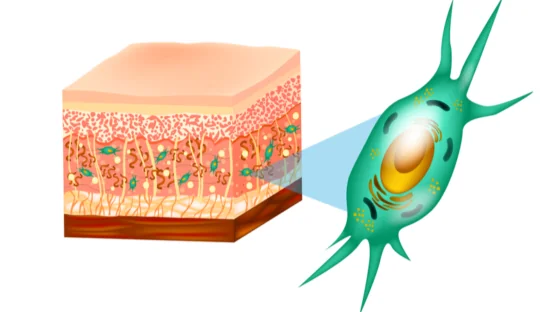Researchers publishing in Aging have identified an individual protein, secreted frizzled-related protein 4 (SFRP4), that is produced by senescent cells and contributes to skin aging in mice.
The spread of the SASP

Read More
The authors of this paper introduce this topic with a familiar discussion of the senescence-associated secretory phenotype (SASP) and how it can lead to a gradual cascade of cellular senescence. They cite a study showing how fibroblasts, the cells that produce collagen and maintain the extracellular matrix, are affected in this way [1].
It has also previously been found that SFRP4 is upregulated with aging and that this molecule promotes cells to become senescent [2]. This compound serves a normal function as a direct antagonist to Wnt, a critical signaling pathway that regulates multiple other tissues, including bone [3]. However, with aging, the extra SFRP4 seems to pose a hazard to tissue health, as it promotes bone loss in aging [3] and is linked to tissue fibrosis and poor outcomes in colon cancer patients [4].
This study delved further into this compound, with researchers examining its effects and whether or not it might be a suitable target for interventions.
Cellular analysis
This experiment began with an analysis of cellular senescence, comparing non-proliferating human skin fibroblasts to their proliferating counterparts. As expected, the normal markers of the SASP were found, including interleukins, MMP3, and TNF-α. However, senescent fibroblasts had roughly 3,000 times the SFRP4 of their proliferating counterparts.
The researchers then determined if SFRP4, as a part of the SASP, drove other cells senescent. Administering SFRP4 to a culture of proliferating human fibroblasts delivered stark results: the proliferating cells behaved more like senescent cells, producing the common SASP components at nearly the same rates as senescent cells.
Then, the researchers did the opposite: through the use of silencing RNA, the researchers prevented senescent fibroblasts from expressing SFRP4. The results were equally stark in the other direction: these fibroblasts expressed dramatically less of every measured component of the SASP
With the relationship between SFRP4 and the SASP confirmed in fibroblasts, the researchers then went on to test their findings in an animal model.
Knocking out SFRP4 promotes skin health in old mice
In this experiment, the researchers used four groups: young 15-week-old mice, a control group of 90-week-old mice, another control group of 90-week-old mice given an ineffective RNA treatment, and finally a group of 90-week-old mice given an effective RNA treatment against SFRP4 over four weeks.
As in the human cell tests, the reduced expression of the SASP in these mice’s skin was stark. Every portion of the SASP was decreased in the treatment group compared to the aged control groups. The skin of the treated group looked much more like the skin of the young mice under the microscope, with thicker, more youthful collagen structures.
Conclusion
While hardly unknown, SFRP4 seems to be a much stronger and much more prominent component of the SASP, at least in fibroblasts, than was previously known. If these results are found to hold true in human clinical trials, it may be possible to create a therapy that attacks excessive SFRP4 production at its source, discouraging the spread of the SASP, fighting cellular senescence, and potentially offering people an effective treatment for skin aging.
Literature
[1] Nelson, G., Wordsworth, J., Wang, C., Jurk, D., Lawless, C., Martin‐Ruiz, C., & von Zglinicki, T. (2012). A senescent cell bystander effect: Senescence‐induced senescence. Aging cell, 11(2), 345-349.
[2] Marthandan, S., Baumgart, M., Priebe, S., Groth, M., Schaer, J., Kaether, C., … & Hemmerich, P. (2016). Conserved senescence associated genes and pathways in primary human fibroblasts detected by RNA-seq. PloS one, 11(5), e0154531.
[3] Haraguchi, R., Kitazawa, R., Mori, K., Tachibana, R., Kiyonari, H., Imai, Y., … & Kitazawa, S. (2016). sFRP4-dependent Wnt signal modulation is critical for bone remodeling during postnatal development and age-related bone loss. Scientific reports, 6(1), 1-14.
[4] Nfonsam, L. E., Jandova, J., Jecius, H. C., Omesiete, P. N., & Nfonsam, V. N. (2019). SFRP4 expression correlates with epithelial mesenchymal transition-linked genes and poor overall survival in colon cancer patients. World journal of gastrointestinal oncology, 11(8), 589.




